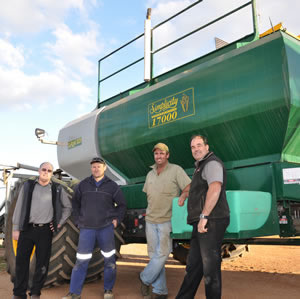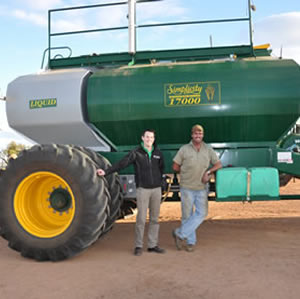- HOME
- PRODUCTS
- RESOURCES
Download PDF Versions of our Equipment Brochures
Brochures
Seeder Controllers
Operator Manuals
Parts Manuals
Additional Resources
Older Parts Manuals
- VISIT DEALER
- COMPANY
 DEALER LOGIN
DEALER LOGIN
Testimonials
Efficiency rules at the Cobley family’s farm

Efficiency rules at the Cobley family’s farm, Lamda, at Geraldton in Western Australia where about 5000ha of wheat, canola and lupin crops are planted annually.
Proponents of minimum tillage techniques for about 25 years, the Cobleys use GPS to two centimetre accuracy and variable rate application technology to ensure their crops are given the best start possible.
The most recent weapon in the Cobley’s sowing armoury is a new Simplicity air seeder which has a 17,000 litre capacity and four compartments or bins. The 17,000 litre Simplicity cart is a tow-between set up with an 18 metre seeding bar and Case IH Quadtrac 535 tractor.
The Cobleys bought the Simplicity bin earlier this year to upgrade to a larger air seeder with liquid. Their previous cart was a 9000 litre Simplicity, which Darren Cobley said they had a fantastic run with.
“When we bought the 9000 litre Simplicity cart, it was a triple-bin set up. There weren’t many of those around back then and it gave us plenty of flexibility for applying different products at sowing,” Darren said. “For example, it allowed us to place 25 per cent of the urea at the seed depth and the rest slightly deeper so the plant could use it later in the season.”
The new Simplicity cart gives the Cobleys even more flexibility with three bins available for granular products and a new, fully integrated tank for liquids. Darren said the addition of the liquid bin, which has a 5000 litre capacity, allows them to sow seed, potash, a compound fertiliser and a liquid at the same time.
“It’s fair to say it’s all happening on the seeder. With the deep-banding set up, there’s 210 outlets on the seeding bar,” Darren said. “But at the end of the day, it makes the operation more efficient as we can be very precise with the input quantities to match our yield and paddock mapping data. We are always looking for ways to become more efficient and with the seeder, Simplicity quad-bin cart and variable rate application; I reckon we have 60 per cent better efficiency with certain products by using deep banding compared with broadcasting.”

Darren is also impressed with how easy the Simplicity is to use.
“This was our first year using liquid fertiliser and we had two new overseas workers here for sowing but they were full bottle with the set up within a few days. It’s very simple to calibrate and you can do all three granular bins at once. You just manually crank a small handle to fill a sample tray which you then weigh and then enter the weight into the X20 controller. The machine and software does the rest.
“And from having to sow about 400 tonnes of fertiliser, we were within one or two per cent. So it’s very accurate.”
Simplicity has made a few slight tweaks to the cart’s design to suit Darren’s specific requirements, and the seeder has a number of factory fitted options such as eight-way metering. This means there are eight primary hoses delivering product instead of the standard six, allowing for higher rate application and more seeding kit options. With potash also being a large part of Darren’s program he has optioned the seeder to have the metering unit built entirely of stainless steel, all but eliminating any potential for corrosion.
“For such a large capacity cart, it’s quite compact,” Darren said. “It’s a very tight fit but completely user friendly. There is plenty of access both around and on top of the cart with ample ladders and platforms and one person can fill all four compartments in 10-15 minutes.”
The proof of the pudding for any seeding set up is germination results and Darren said despite one of the driest Junes on record, his crops were performing well. “After one of the best starts to the season ever, June was a record dry period. So it was even more important that seed depth and placement were as accurate as possible. We were able to get enough nutrients out at seeding and that has resulted in a very even germination.”
© 2024 Simplicity Australia ~ Manufacturers of Australia's Favourite Airseeder







 Trailing Seeders
Trailing Seeders